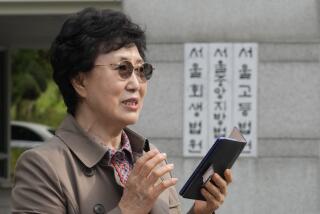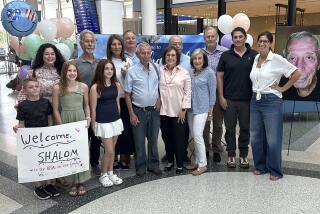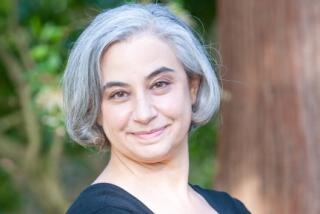Sisters Linked in the Lab
A decade ago, Denise Shields of Laguna Niguel and Nancy Hinkeldey of Orlando, Fla., went to China with a group of other Americans intent on adopting.
Shields had lost her husband and was aching to raise a child. Hinkeldey, a single mother with one adopted child, wanted another. Their mutual yearning was satisfied at an orphanage in the southern city of Nanning. Each flew home with a baby girl.
Over the years, Shields sent holiday photos of her daughter to the other families who had made the trip. As the photos piled up, Hinkeldey began seeing subtle similarities between Emily Shields and her daughter Anna. She saw it in their jaws and cheek lines, in their eyebrows and foreheads, in their hairlines.
Last July, as the girls romped on the beach at their travel group’s 10-year reunion on Amelia Island, Fla., the mothers compared notes.
Both girls had been late losing their baby teeth. Both were academically gifted, musical and artistic.
Then Shields noticed a peculiar indentation on the back of Anna’s right thigh. She grabbed Hinkeldey’s arm and blurted out: “Anna has the same mark Emily does!”
The two women discussed with their daughters the idea of DNA testing. Anna and Emily agreed. The news came in August: The girls shared at least one birth parent, making them biological half-sisters. The lab could not rule out the possibility that they had both parents in common.
DNA testing has been used for years to convict felons and clear those who’ve been wrongly accused. Now, families are turning to the technology to establish biological links between adopted children living in different households, often hundreds or thousands of miles apart.
In doing so, they are penetrating the mystery that often surrounds adoption and recovering bits of the lost history of children from China, Russia and other foreign lands, many of whom were delivered to their adoptive families as foundlings, with little or no information about their origins.
One e-mail group has drawn more than 60 adoptive families who serve as a far-flung support group. Many of those parents say they have spotted children on family or orphanage websites who bear strong resemblances to their own. Some have confirmed blood relationships through DNA testing.
Recently, two families in Arizona and Alabama learned that their adopted children from China -- both born with cleft palates -- were at least biological half-siblings.
In August, a company in Princeton, N.J., announced that it had agreed to conduct genetic testing for a nonprofit registry that is believed to be the first to focus on using genetic profiles to reunite siblings after adoption. Other such registries are scrambling to enter the market.
The practice is stirring up a commotion in adoption circles. Some adoption specialists and bioethicists say they fear that unscrupulous labs will exploit parents eager to fill in the missing pieces of their children’s lives.
Another worry is that adopted children could find the sudden discovery of a sibling profoundly unsettling. Some experts say parents should wait until their children reach adulthood and let them decide whether and how to seek out long-lost family members.
Bioethicists and educators also caution that DNA tests conducted without genetic material from the parents (typically the case with children from China) can often prove inconclusive.
“Before we all go flying off getting our DNA tested, we need to have some thought given to what is going to happen when we get these results and how we’ll interpret them,” said Jane Gitschier, a professor of medicine and pediatrics at UC San Francisco.
The push for DNA tests would seem to go against a central tenet of adoption: that families created through that process are just as authentic as those based on blood relationships.
Hinkeldey and Shields believed they owed it to their daughters to find out whether the similarities between them were accidental or hereditary.
“We felt it would be doing them a disservice not to,” Hinkeldey said.
Both mothers knew it was a long shot and said as much to their daughters. “I talked with Anna about the possibility of disappointment,” said Hinkeldey, a psychologist. “I told her this was a very unlikely thing.”
Hinkeldey said she was also concerned about how her other adopted daughters -- Eva, 12, and Lily, 5 -- would react if their sister learned she had a blood relative. As it turned out, they were overjoyed by the discovery and have welcomed Emily Shields into their family.
The decision to seek DNA testing involved a leap of faith akin to that the mothers took when they adopted in the first place.
“I absolutely wanted a child,” Hinkeldey, 48, said of her life before adoption. “It was something I needed to do.”
Hinkeldey had witnessed firsthand the uncertainties of foreign adoption. In early 1992, she flew to Peru to help a brother whose effort to get his newly adopted baby out of the country had been stymied by bureaucracy. It took six months before the father could leave the country with his daughter.
Leery of adopting in Latin America, Hinkeldey was thrilled to see a notice late that summer that China was opening to adoptions. She applied through an agency in September of that year and by December had her first daughter, Eva. (The process now takes about 18 months.)
By 1994, she was ready emotionally and financially to take on child No. 2. That’s when she and Eva, who also made the trip to China, met Shields. They were among 10 families, from the East Coast, Texas, Ohio and California, who had received “referrals” from Chinese authorities to adopt children in Nanning, in the southern province of Guangxi.
Shields, 49, had been married a year when her husband died in an accident in 1987.
“We’d always planned to have a child and adopt a child,” Shields said. In 1993, after reading about adoptions of Chinese babies, Shields said she “had a calling so deep in my heart. I looked at my parents and said: ‘How would you feel being the grandparents to a Chinese child?’ My dad smiled from ear to ear.”
On Nov. 7, 1994, Emily was placed in her arms in Nanning. Hinkeldey received Anna the same day.
In the decade since, the 10 girls adopted by members of the Nanning travel group have called themselves “the China Sisters,” connected by a bond their families believe to be as deep as any biological tie.
As Emily grew, she pined for a sister. In Florida, Anna, despite having an older and, later, a younger sister, sometimes felt lonely. “I felt like a little part was missing,” she would say later.
Hinkeldey had heard scattered reports of adoptees’ discovering blood connections through DNA testing. Soon after last summer’s beach reunion, she began searching the Internet for information.
She found an e-mail group called Sister Far, started by Susan and Jim Rittenhouse of Lisle, Ill. Participants include the families of more than 60 suspected or confirmed sets of twins and other siblings, most from China but also from Cambodia, Russia and Nepal.
The families, who live in the United States, Europe and Australia, share news and tips and discuss how to deal with issues that can arise when families are suddenly thrown together by the possibility -- or the certainty -- that their children share bloodlines.
Jim Rittenhouse said the couple started Sister Far earlier this year after tests indicated “a strong certainty” that their daughter, Meredith Grace, was the biological sibling of a girl in Alabama whose spitting-image photo they had seen on an e-mail list for families with children from Jiangmen. That child, coincidentally, was named Meredith Ellen.
Through Sister Far, Shields and Hinkeldey encountered stories that were positive, even joyous. The reports encouraged the two mothers to proceed with DNA testing.
Given the many unknowns about adoptive children from China, the odds of locating a “bio sib” are impossible to calculate.
Tens of thousands of children (most of them girls) are abandoned in China each year by birth parents who fear that they will be fined, even sterilized, for violating population control laws. Many of the foundlings are adopted by Chinese families. Thousands of others head for new homes in the United States, Europe and Australia.
Like other parents in their situation, Hinkeldey and Shields set out to become experts in a field in which authorities of long standing disagree on important points, such as how many genetic markers must be tested to achieve reliable results.
Shields, a business consultant, heard from a client about Genex, a Vancouver lab with the website www.swabtest.com. Shields said the company cautioned that, without genetic material from the biological parents, test results could prove ambiguous. Some full siblings, for example, might not share any of the tested markers.
To complicate matters, even biologically unrelated individuals might by chance share a number of markers.
The two women paid $145 each for a “siblingship” test. They rubbed the insides of their daughters’ cheeks with cotton swabs and sent the packets to the lab.
Two weeks later, Hinkeldey and her daughters flew to New Hampshire for a family reunion. While the Hinkeldeys were in the air, Shields called Genex to ask if the test results were available.
A lab employee told Shields the girls were “at least half-siblings.” Shields asked: “Are you saying they are sisters?”
The answer: “Yes.”
Shields brought her daughter into her home office and shared the news. Next, she called her parents. Then, she tried Hinkeldey’s cellphone dozens of times before finally reaching her just as she got off the plane -- an hour and a half late. On hearing the news, Hinkeldey started screaming. The whole family celebrated.
Anna and Emily have spent hours burning up the phone and e-mail wires with questions: What’s your favorite movie? Your favorite school subject? What pets do you have?
The mothers, meanwhile, have begun adjusting to a different family dynamic. The women say they are developing a strong bond, despite their contrasting personalities.
The outgoing Shields, who has long dark-blond hair, has gone diving with Jean-Michel Cousteau and in 1977 was Miss New Mexico Universe. Hinkeldey, who has thick silver-blond hair, is more reserved. She spent long winters in the 1980s in Minnesota, where she had a post-doctoral fellowship at the Mayo Clinic.
Since adopting Eva, now a promising gymnast, Hinkeldey has returned to China several times with her daughters. Last year, she and the girls, working with a nonprofit, helped build two preschools in orphanages in Guangxi province.
In August, the growing interest in genetic testing of adopted children prompted Orchid BioSciences Inc. to announce an agreement with a genetic database focused on reuniting siblings after adoption. The database would be controlled by Kinsearch Registry, a new nonprofit entity.
Kinsearch would charge $35 for registration and screening, then $400 for an initial DNA test. If the results showed a match with another adoptee, the family could elect to pay $200 for another test to refine the results.
Charging fees rankles some in the adoption community.
“How much of this is about making money?” asked Jane Brown, a social worker in Scottsdale, Ariz., who runs workshops on trans-racial adoption.
Brown said she worried that discovering siblings could be disruptive as well as costly. She cited a case in which two pairs of adoptive parents, after learning that their sons were siblings, made contact -- and clashed. One family cut the other off, leaving the two boys angry and grieving.
Such a possibility seemed far from the minds of 10-year-old Anna Hinkeldey and Emily Shields when they visited Los Angeles’ Chinatown on a recent Sunday afternoon. For weeks, they had been counting the days until this three-day weekend -- the families’ first get-together since they heard the DNA results.
At Los Angeles International Airport, they had hugged joyously. “It was comfortable, and they both seemed really happy,” Hinkeldey said.
A stranger seeing the girls for the first time would not assume they were sisters. Anna is more slender and has much longer hair. But when the girls turned their heads slightly to look at merchandise in an outdoor stall, the similarities in their eyebrows, foreheads and hairlines stood out.
The four adopted Chinese girls in the two families are enjoying their new-found relationship. Emily Shields has gained not just the one sibling she had been craving, but three. Eva Hinkeldey is happily tackling the role of big sister not just to Anna and Lily, but to Emily as well.
“It was a miracle,” Shields said. “Emily has always wanted siblings, and she was delighted the first day of school to say in her new classroom that she has three sisters.”
Though all wish they were closer, neither family has plans to relocate. Hinkeldey has a busy practice in Florida; Shields’ consulting business ties her to Laguna Niguel. But they have booked a Florida beach house for next summer and look forward to forging a closer bond between their girls, for whom “China Sisters” has taken on new meaning.
“We’re a separate family, they’re a separate family, but we’re related,” Hinkeldey said. “These things are still evolving. Our understanding may be different next year. As it is now, everybody seems happy we found the connection.”
More to Read
Sign up for Essential California
The most important California stories and recommendations in your inbox every morning.
You may occasionally receive promotional content from the Los Angeles Times.











